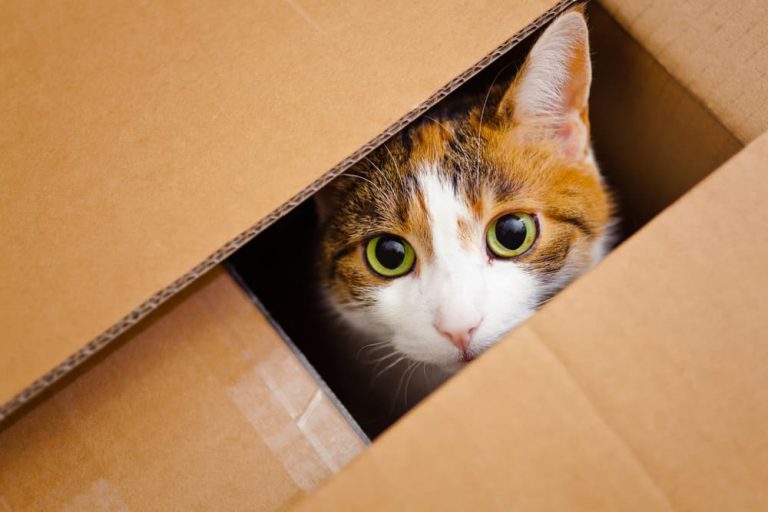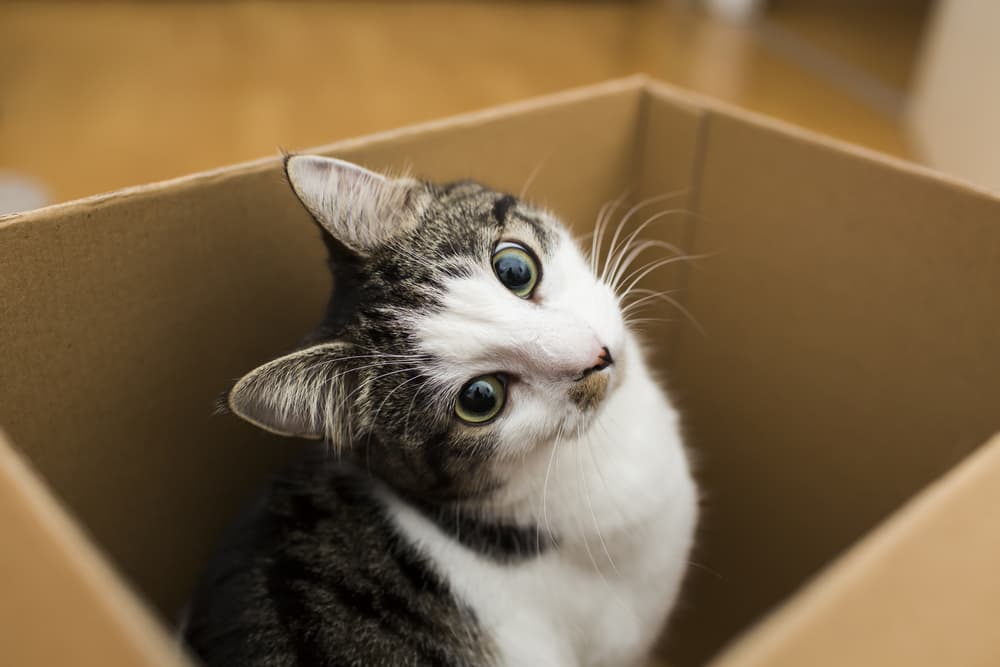Why Do Cats Like Boxes?

If you’re looking for your cat around the house, it might be a good idea to check the cardboard box you’re planning to recycle. Our feline family members seem to love boxes. They play with them, sleep in them, and jump in and out of them. But why do cats like boxes?
Our experts say there are sound reasons for the behavior, rooted in feline survival instincts. By understanding the natural reasons why cats love boxes, we can provide more cat furnishings that provoke happiness in our favorite felines – or just more boxes.
Cats and Boxes: A Tale as Old as Time
It’s a common problem: You bought the most lavish toy, bed, or tree for your cat, but she’d rather hang out in the cardboard box it came in. As a proud cat parent and a feline behavioral clinician in Portland, Oregon, Dr. Katherine Pankratz gets it.
Like many cat parents, Pankratz has found herself “constructing the most elaborate cardboard castle” for her cat. Only to find him happily snoozing in a shallow cardboard box tossed aside for recycling. “And that was alright,” she concludes.
You might never change your cat’s affinity for the tried-and-true box, and the truth is, maybe we shouldn’t try to. Before we try to change a cat’s behavior, it’s important to understand it. When considering why so many cats swoon over boxes of all shapes, sizes, and wear-and-tear, consider what needs they might be fulfilling with the box.
Do All Cats Like Boxes?

Each individual cat has their own preferences. While many enjoy snoozing or hiding in a box, not all cats will want to be confined.
Samantha Bell, cat expert at Best Friends Animal Society in Los Angeles, describes cats as “tree-dwellers” and “bush-dwellers.”
Bush-dwelling cats gain confidence from all four paws on the ground, ready to pounce from their hiding spot at a moment’s notice. In comparison, tree-dwelling cats love to stalk from high-up places, like a wild jaguar surveying its forest.
Cats don’t always fit into just one of these boxes (pun intended). So, Bell says that it’s thoughtful to provide your cat with bush-dwelling spaces like boxes for cats, tents, and beds and tree-dwelling spots like cat trees, shelving, and perches. The more you get to know your cat, the better you can furnish the space just for her.
Why Do Cats Like Boxes?

We may never know exactly what your cat is thinking or why she prefers one spot of the house over the other. But, based on existing research and years of sharing our homes with the domesticated feline, Dr. Brian Evans, veterinarian at Dutch, has some thoughts about why cats love sitting in boxes, playing in boxes, and sleeping in boxes.
Safety
Cats are fierce hunters. But while they’re hunting prey, a predator could be hunting them. This might not be exactly true for your happy housecat, but your cat hasn’t lost touch with their wild instincts to seek out safety.
“Small spaces provide comfort for cats,” Dr. Evans explains. “There is less chance they can be attacked from behind if they are in an enclosed space.”
In fact, the use of boxes as a comforting space was put to the test by a group of researchers and Dutch shelter cats. The study found that cats with access to cardboard boxes acclimated to their environment faster than cats that were not given the boxes. This insight could be useful for cat parents planning a move. “In times of stress, cats like to hide,” adds Dr. Evans. “So, providing a safe place for them to sneak away can be very helpful.”
Hunting
Boxes that are readily available and easily accessible make a convenient hideout for pouncing at prey. No matter the shape or size of a box, a cat can seemingly melt into it like a liquid (or at least they think they can). It’s here that they believe their human companion or play mouse can’t see them crouching, waiting to strike.
Curiosity
Cats are naturally curious creatures, in part due to their unique placement in the food chain. They have an instinct to observe, investigate, and learn. This includes “exploring the nooks and crannies of their environment,” Dr. Evans says.
Warmth
Is your cat always seeking out the nearest sunspot or the coziest cardboard box? A cat’s normal body temperature (4 weeks and older) is 99.5 to 102.5 degrees, just a few degrees higher than ours. Generally, cats are the most comfortable when temps linger between 60 and 80 degrees.
When a cat’s body temperature drops below 99.5 degrees or inches above 102.5 degrees, warm and cold receptors throughout the body shoot signals to a part of the brain called the hypothalamus. The hypothalamus decides if the body is too cold or too warm, then triggers biological reactions (shivering or sweating through the paw pads) and behavioral responses (moving towards heat or away from heat sources).
What does this have to do with a cat in a box? “Cardboard has natural insulation that helps to keep your cat warm and snuggly, making it an ideal place to nap,” Dr. Evans says.
Kitten Instincts
When your cat was born, they likely arrived in a cozy nest of blankets placed in a box or other small, enclosed space. Even if they were born outdoors without humans, mother cats (known as queens prepare) a cozy nest about 63 days into their pregnancy.
It’s here in their nesting box that your cat spent their first few weeks of life, being dotted on and cared for by mom. A snug box might feel like a happy kitten experience. It’s even thought that the feeling of an extra-small box pressed against a cat could stimulate the release of endorphins, or the feeling of happiness and reduction of stress.
Are Boxes Beneficial for Cats?
Pankratz didn’t feel frustrated when her cat chose a box meant for the trash over her thoughtfully chosen castle. “Providing for your cat’s environmental needs through their individual preferences can significantly decrease their stress and improve their welfare,” she says.
Sure, a cardboard box isn’t as aesthetically pleasing as enriching furniture that boasts style and function, but boxes are cheap (or free) and they make your cat happy.
If it’s time to toss your old boxes, Dr. Evans says to look for cat trees with cubbies, to spoil your feline with her own cat tent, or simply leave the cat carrier out with favorite blankets. “The added benefit of using the carrier is when you need to put them in it for a trip, they are already comfortable with the spot.” Rather than forcing your cat to lounge in the new spot, encourage them to explore on their own with the help of treats, catnip, and play.
Box Safety for Cats

Before leaving a box out for your cat’s enjoyment, there are things you should do to ensure your feline’s safety. Follow these tips:
Remove potential dangers. Take the time to remove any sharp edges or objects like staples, cut off any loose tape your cat could ingest or stick to, and double check that all of its contents have been removed – like packets of silica gel or plastic bags.
Keep it on a steady surface. “If you keep empty cardboard boxes on top of an unsteady side table, your cat may not find the tumble to the ground very relaxing,” Dr. Evans adds. So, ensure it’s on a sturdy surface or planted on the ground.
Make sure cats can exit the box. While we can’t guarantee your cat won’t want to spend all their time in your thoughtfully placed box, keep it clear of any obstructions that could cause your cat to become trapped inside.









